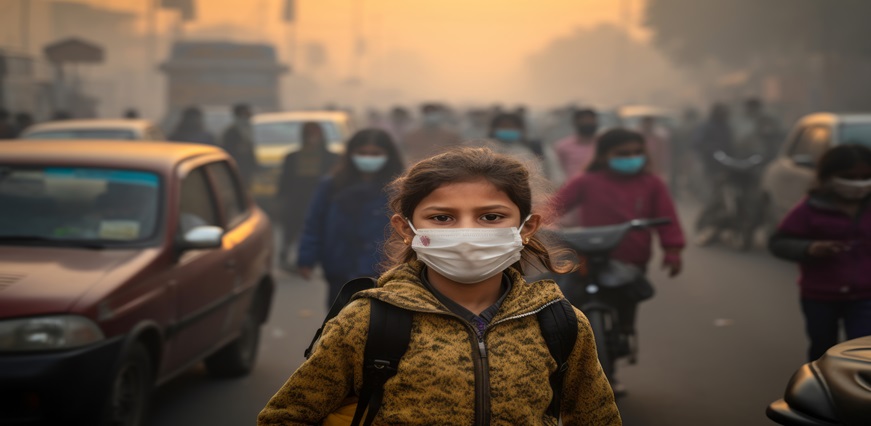Air pollution is no longer just an environmental issue; it has become a public health crisis of epic proportions in India. A recent study by researchers at the Karolinska Institute in Sweden, published in The Lancet Planetary Health, has exposed the shocking toll of long-term exposure to fine particulate matter (PM2.5) on human life. The findings highlight an urgent need for stricter air quality measures in the country, as the sheer scale of deaths linked to air pollution is staggering.
The Deadly Menace of PM2.5: PM2.5 refers to microscopic air pollution particles with a diameter smaller than 2.5 micrometres. Because of their small size, these particles can easily bypass the body’s natural defences and penetrate deep into the lungs. From there, they can enter the bloodstream, triggering a cascade of health problems.
The study, which analysed data from 655 districts in India between 2009 and 2019, revealed a direct link between PM2.5 levels and mortality rates. For every 10 micrograms per cubic metre increase in PM2.5 concentration, there was an 8.6% rise in deaths. This stark statistic is a sobering reminder of the invisible dangers we face every day.
Millions of Deaths Attributed to Air Pollution: The decade-long study estimated that approximately 3.8 million deaths were caused by air pollution levels exceeding India’s national guideline of 40 micrograms per cubic metre. This is even more alarming when compared to the stricter World Health Organization (WHO) recommendation of 5 micrograms per cubic metre.
By the WHO’s benchmark, the study linked 16.6 million deaths, nearly a quarter of all deaths during the period to air pollution. These are not just numbers on a chart but lives lost, families shattered, and communities devastated.
India’s Air Pollution Crisis in Numbers: Shockingly, every single person in India lives in areas where PM2.5 levels exceed WHO guidelines. In some regions, the concentrations are astronomically high. For example, in 2016, Ghaziabad in Uttar Pradesh and Delhi recorded PM2.5 levels of 119 micrograms per cubic metre—nearly 24 times the safe limit.
While the lowest PM2.5 levels during the study were found in Lower Subansiri district, Arunachal Pradesh, at 11.2 micrograms per cubic metre, even this figure exceeds the WHO’s safe threshold.
An Increasing Trend of Deaths: The study also documented a worrying rise in deaths linked to air pollution. In 2009, the death toll stood at 4.5 million. By 2019, this number had climbed to 7.3 million. The increase mirrors the worsening air quality in many parts of the country, despite initiatives like the National Air Pollution Control Programme (NCAP) launched in 2017.
Why Is Air Pollution So Deadly?
PM2.5 particles pose severe health risks because they are small enough to travel deep into the lungs and enter the bloodstream. Once inside, they can cause:
Respiratory Issues: Chronic bronchitis, asthma, and other lung conditions.
Cardiovascular Diseases: Increased risk of heart attacks and strokes.
Neurological Effects: Emerging evidence suggests links to cognitive decline and mental health issues.
The research also highlighted an increase in fibrinogen levels, a protein involved in blood clotting, in people exposed to higher PM2.5 levels. Elevated fibrinogen can lead to blood clots, increasing the risk of strokes and heart attacks.
Ineffectiveness of Current Air Quality Standards: India’s current air quality guidelines, which set a limit of 40 micrograms per cubic metre for PM2.5, are insufficient to protect public health. These standards are much laxer than the WHO guidelines of 5 micrograms per cubic metre. According to lead researcher Petter Ljungman, “The current air quality guidelines in India are insufficient to safeguard health. Stricter regulations and decisive measures to cut emissions are urgently needed.”
Geographical and Seasonal Variations: India’s vast geographical diversity means that air pollution levels vary widely across regions and seasons. Urban areas, especially in northern India, experience the worst air quality due to industrial emissions, vehicular traffic, and crop-burning practices. Rural areas are not spared either, as biomass burning for cooking contributes significantly to PM2.5 levels.
The seasonal variation is also stark, with winter months often seeing a dramatic spike in pollution levels due to temperature inversions and slower wind speeds.
Global and Local Dimensions of Air Pollution: Air pollution is not just a local issue; PM2.5 particles can travel hundreds of kilometres, crossing state and even national boundaries. This long-range movement of pollutants means that addressing air pollution requires both local and international cooperation.
The study emphasized that while local measures to reduce emissions are crucial, they must be coupled with strategies to address cross-border pollution.
Beyond its impact on health, air pollution also has significant economic consequences.
1. Healthcare Costs: The treatment of diseases caused by air pollution strains India’s already overburdened healthcare system.
2. Lost Productivity: Illnesses and premature deaths reduce the workforce, affecting economic growth.
3. Social Inequity: The poor, who often rely on biomass for cooking and live in densely polluted areas, bear the brunt of air pollution’s effects.
What Needs to Be Done?
The fight against air pollution requires a multi-pronged approach:
1. Stricter Regulations: Aligning India’s air quality standards with WHO guidelines.
2. Cleaner Energy: Transitioning to renewable energy sources to reduce dependence on fossil fuels.
3. Improved Public Transport: Encouraging the use of public transportation to reduce vehicular emissions.
4. Awareness Campaigns: Educating the public about the health risks of air pollution and ways to minimize exposure.
5. Technology and Innovation: Investing in technologies like air purifiers and emission control systems.
India is at a crossroads. The choices made today will determine the health and well-being of future generations. This study serves as a wake-up call, urging policymakers, industries, and individuals to act decisively.
The Swedish researchers behind the study have provided invaluable evidence to support stronger air quality policies. However, it is up to India to turn this evidence into action.
While the statistics are grim, they also present an opportunity for change. With nearly 1.4 billion people affected, even small improvements in air quality can have a massive impact.
The journey towards cleaner air will not be easy, but it is essential. For the sake of our health, our environment, and our future, it is time to breathe life into the fight against air pollution
http://www.21stcenturyhospitalgownplus.com/
http://www.elite-factory-15.fr/
http://www.gba-amateurboxen.de/
http://www.kita-strausberg.de/
http://sonispicehelensburgh.co.uk/
http://curryzonecardonald.co.uk/
http://cinnamon-edinburgh.co.uk/
http://www.bombaydelipaisley.com/
http://pizzanightclydebank.co.uk/
http://www.pizzanightclydebank.com/
http://gyros2goclydebank.co.uk/
http://grillicious-glasgow.co.uk/
http://www.abdulstakeaway.com/
http://www.freddiesfoodclub.com/
http://cinnamonportobello.co.uk/
http://www.romafishnchips.com/
http://bombaydelipaisley.co.uk/
http://yaraloungerestaurant.co.uk/
http://tasteofchinacoatbridge.co.uk/
http://www.memoriesofindiagorebridge.com/
http://memoriesofindiaeh23.co.uk/
http://freddiesknightswood.co.uk/
http://gyros2gohardgate.co.uk/
http://www.strausseeschwimmen.de/
http://www.janstanislawwojciechowski.pl/
http://london-takeaways.co.uk/
http://shahimanziledinburgh.co.uk/
http://freddiesfoodclub.co.uk/
http://www.spicestakeaway.com/
http://www.mexita-paisley.com/
http://pandahouseglasgow.co.uk/
http://www.zum-alten-steuerhaus.de/
http://www.oberstufenzentrum-mol.org/
http://www.morsteins-neuenhagen.de/
http://www.maerkische-jugendweihe.de/
http://www.planungsbuero-henschel.de/
http://www.hertzelektronik.de/
http://www.militaergefaengnisschwedt.de/
http://www.fahrrad-naumann.de/
http://www.hondamoto-villemomble.com/
http://www.hondamoto-royan.com/
http://www.hondamoto-ajaccio.com/
http://www.download-skycs.com/
http://www.sisakoskameleon.hu/
http://www.hondamoto-montauban.com/
http://www.hondamoto-chalonsursaone.com/
http://www.hondamoto-champignysurmarne.com/
http://www.hondamoto-asnieres.com/
http://www.pasquier-motos.com/
http://www.evacollegeofayurved.com/
http://www.compro-oro-italia.it/
http://www.hondamoto-saintmaximin.com/
http://www.hoangminhceramics.com/
http://www.pasiekaambrozja.pl/
http://www.xn--b1alildct.xn--p1ai/
http://www.ferreteriaflorencia.com/
http://www.thevichotelkisumu.com/
http://www.nexuscollection.com/
http://www.moitruongminhhuy.com/
http://www.ozkayalarpaslanmaz.com/
http://www.munkagepmonitor.hu/
http://www.my247webhosting.com/
http://www.thesmokingribs.com/
http://www.healthlabgrosseto.it/
http://www.ochranakaroserie.cz/
http://www.phukiendonginox.com/
http://www.meijersautomotive.nl/
http://www.kartaestudentit.al/
http://www.podlahyjihlavsko.cz/
http://www.hillhouseequestrian.com/
http://www.gradskapivnicacitadela.com/
http://www.capella-amadeus.de/
http://www.landfleischerei-auris.de/
http://www.faistesvacances.be/
http://www.autoservice-doernbrack.de/
http://www.tabakhaus-durek.de/
http://www.oldtimer-strausberg.de/
http://www.imexsocarauctions.com/
http://www.kaslikworkshop.com/
http://www.firefightercpr.com/
http://www.visuallearningsys.com/
http://www.hanksautowreckers.com/
http://www.impresospichardo.com/
http://www.philiphydraulics.net/
http://www.internationaldentalimplantassociation.com/
http://www.indywoodtalenthunt.com/
http://www.badicecreamgame.com/
http://www.riad-amarrakech.com/
http://www.centrodeformacioncanario.com/
http://www.socialdefender.com/
http://www.pepiniere-paravegetal.com/
http://www.reparertelephonearles.fr/
http://www.namsontrongdoi.com/
http://www.devipujakjivansathiseva.in/
http://www.laymissionhelpers.org/
http://www.vangiaphatdeco.com/
http://www.isscoachinglucknow.in/
http://www.hieuchuandoluong.com/
http://www.aurorabienesraices.com/
http://www.indianmoversassociation.com/
http://www.oztopraklarotomotiv.com/
http://moitruongnamnhat.com.vn/
http://www.dienmayvinhthuan.vn/
http://www.divadelkoproskoly.cz/
http://www.xn--12cfje1df4hdl7f1bf2evg9e.com/
http://www.westernirontrailers.com/
http://www.jazzaufildeloise.fr/
http://www.signcraft-drone.com/
http://www.realtyhighvision.com/
http://www.thermexscandinavia.nl/
http://imobiliariafelipe.com.br/
http://www.salon-lindenoase.de/
http://www.jezirka-zahrada.cz/
http://www.singhanialogistics.in/
http://www.der-pixelmischer.de/
http://www.hegermuehlen-grundschule.de/
http://www.radiologie-strausberg.de/
http://www.foto-studio-matte.de/
http://www.tables-multiplication.com/
http://www.rusztowania-belchatow.pl/
http://www.fishingandhuntingheaven.com/
http://www.orologiegioiellilameridiana.it/
http://www.rotarybresciaest.org/
http://www.jacarandaspain.com/
http://www.javieririberri.com/
http://www.huebelschraenzer.ch/
http://www.illinoiscreditunionjobs.com/
http://www.iznikdenizorganizasyon.com/
http://www.leasebackconcierge.com/
http://www.eoisantacoloma.org/
http://skullbasesurgery.co.uk/
http://www.immobilienplattensee.com/
http://www.germandailynews.com/
http://www.gptdcinternational.com/
http://www.forklifttrainingedmonton.com/
http://www.kashiwanakayama-cl.com/
http://www.thehousemediagroup.com/
http://www.pensiimaramures.ro/
http://www.michaelakokesova.cz/
http://www.viswabrahmanaeducationaltrust.com/
http://krone-aluminium.com.pl/
http://www.broadwaylumber.com/
http://www.ambulancesoccasions.com/
http://www.continuumintegrated.com/
http://www.joilifemarketing.com/
http://www.rotaseydisehir.com/

 While the statistics are grim, they also present an opportunity for change. With nearly 1.4 billion people affected, even small improvements in air quality can have a massive impact.
While the statistics are grim, they also present an opportunity for change. With nearly 1.4 billion people affected, even small improvements in air quality can have a massive impact.





.jpeg)
.jpeg)

_(1).jpeg)
.jpeg)
_(1)_(1)_(1).jpeg)
.jpeg)


.jpeg)





.jpeg)

.jpeg)

.jpeg)
.jpeg)
.jpeg)




